Bucchero › Bucephalus › Ancient Egyptian Medicine: Study & Practice » Origins and History
Articles and Definitions › Contents
- Bucchero › Origins
- Bucephalus › Who Was
- Ancient Egyptian Medicine: Study & Practice › Origins
Ancient civilizations › Historical places, and their characters
Bucchero › Origins
Definition and Origins
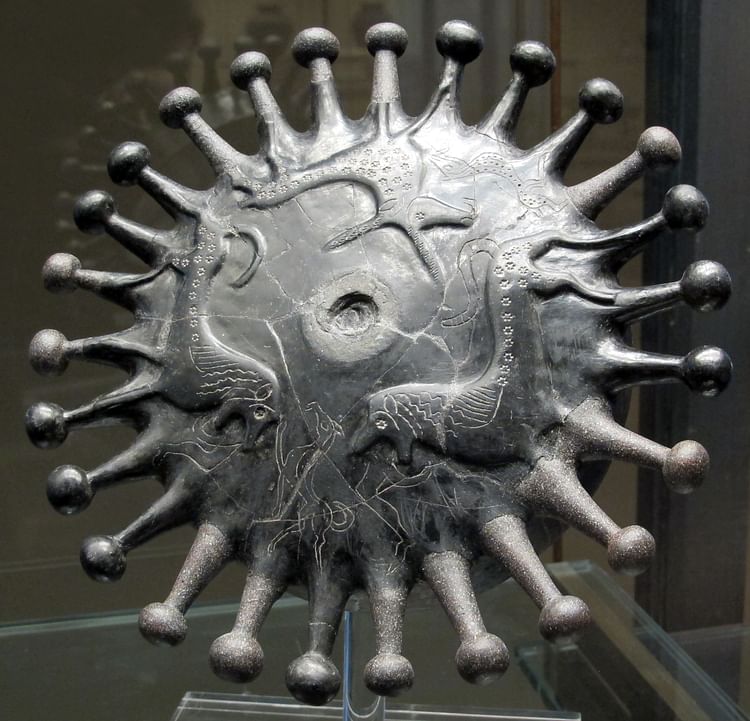
Bucchero wares are a shiny dark grey to black pottery produced by the Etruscans of central Italy from the 7th to 4th century BCE. Used for everyday purposes and as funerary and votive objects, bucchero incorporates many forms from simple jugs to highly decorative pieces of sculpture.
EVOLUTION
In the 8th century BCE, the Etruscans were already producing a rather crude pottery known as impasto which was made of clay containing impurities of mica or stone. Although potters managed to improve the quality of impasto through long practice, it was replaced as the daily pottery of choice by an intermediary type known as buccheroid impasto and then bucchero proper sometime in the early 7th century BCE. Turned on the wheel, this new type had a more even firing and, using the process of oxidation in the kiln, gave a consistent and distinctive glossy dark grey to black finish (the clay's red ferric oxide being turned into black ferrous oxide).
The earliest known examples come from Cerveteri (aka Cisra or Caera) and date to c. 675 BCE. Bucchero was produced in many Etruscan centres (notably Cerveteri, Tarquinia, Veii, and Vulci ) and has become a hallmark of Etruscan presence at archaeological sites in central and northern Italy. The Etruscans were Mediterranean-wide traders, too, and bucchero was thus exported beyond Italy to places afar afield as Iberia and the Levant.
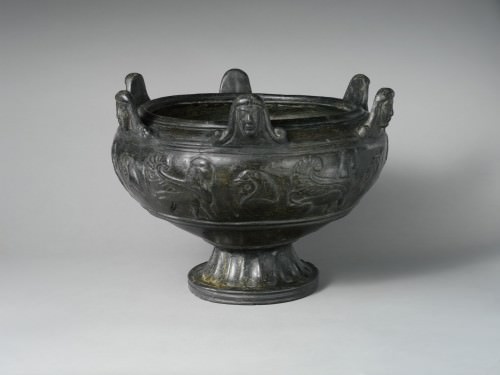
Bucchero Krater
Curiously, bucchero wares display the reverse trend of refinement seen in many other pottery type evolutions. The early period wares are finer with much thinner walls and more carefully made; these are known as sottile (fine). There is then an intermediary stage known as transizionale (transitional) before a final phase when wares are described as pesante (heavy).Finer wares are generally associated with the southern Etruscans cities and the heavier type in the northern. Chiusi became a particularly noted centre for pesante wares, most of them being funerary objects. The dates for each style are usually cited as follows:
- Fine bucchero : 675-626 BCE
- Transitional bucchero : 625-575 BCE
- Heavy bucchero : 575-480 BCE
Eventually, by the early 5th century BCE, bucchero was replaced by finer Etruscan pottery such as black and red-glazed wares, and by imported Greek vessels which were specifically made in Greece to suit Etruscan tastes or made by local and immigrant potters in imitation of popular Greek styles.
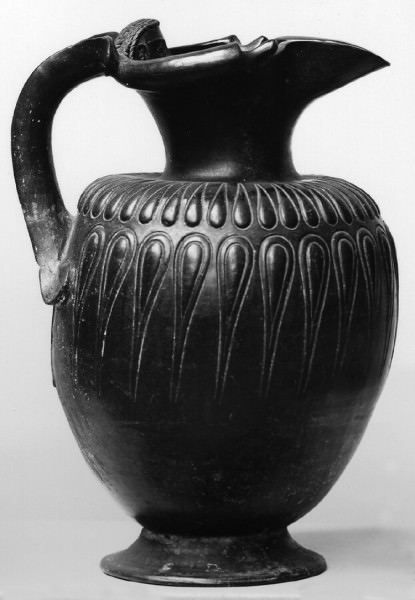
Bucchero Jug
FORMS
Etruscan potters were not without ambition and besides making vessels for ordinary daily use such as bowls, single and two-handled cups, chalices, and jugs, they also made more elaborate pieces with the addition of three-dimensional figures of both humans (especially female heads) and animals. Greek influence is seen in such choices as the ubiquitous amphora and two-handle cup or kantharos. Other forms include votive offerings and wares placed in tombs to accompany the dead into the next life. A common example of the latter are the plain service trays (known as focolare ) complete with bowls, plates, cups, and utensils. Another form of votive offerings was figurines. These are closer to sculpture than pure pottery, as are the anthropomorphic vessels such as the cockerel from Viterbo which has a small lid and, if its inscription of the Etruscan alphabet is anything to go by, functioned as an ink pot.
The forms of bucchero were also influenced by contemporary metalwork, especially bronze goods, and the pottery was probably esteemed for its shiny finish so like burnished metal. Indeed, this imitation sometimes went so far as to manifest itself in some bucchero vases being covered in gold or silver leaf, sometimes also a thin layer of tin. Decorations of ridges and applied sculpted pieces can complete the illusion of embossed metalwork.
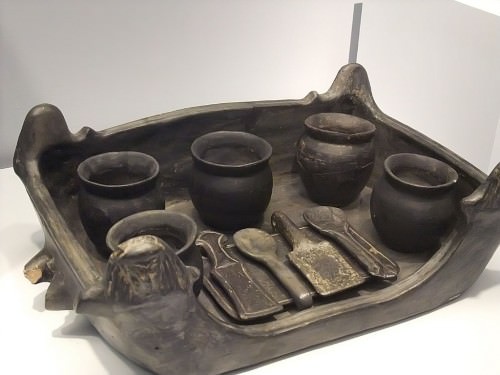
Bucchero Dinner Set
DECORATION
Many bucchero wares were left plain, but decoration, when it occurs, can take the form of simple lines, spirals, and dotted fans incised onto the surface. Red ochre was sometimes painted in these incisions, but very few examples survive with their paint intact. Another decoration is the application of geometric shapes arranged symmetrically around the vessel, giving the illusion the vessel has been pressed from the inside. Many decorative motifs and scenes were influenced, as with other branches of Etruscan art, by Ionian and Near Eastern art. Greek decorated pottery from Attica and Corinth was especially popular in Etruria and incised scenes from Greek mythology are a popular choice for bucchero artists. Patterns and scenes could be applied to the pot before firing using a stamp, either fixed or a roller.
Bucephalus › Who Was
Definition and Origins
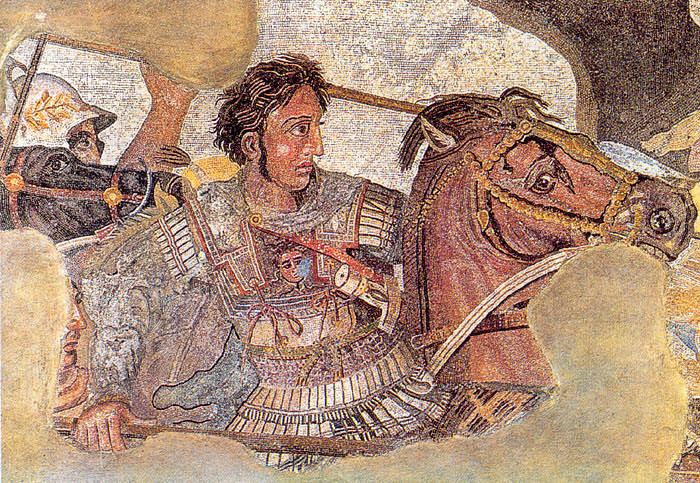
Bucephalus was Alexander the Great ’s horse and is considered by some to be the most famous horse in history. Alexanderand Bucephalus' initial meeting was unique but demonstrated the true character of one of the greatest generals in all of history.Initially, Bucephalus was brought to Macedonia and presented to King Phillip II (Alexander's father) in 346 BCE by Philoneicus of Thessaly. With a price tag almost three times the norm (13 talents), the beautiful black horse stood taller than the normal Macedonian steed but was considered too wild and unmanageable, rearing up against anyone who came near him. Phillip ordered him led away.
Alexander sat in the audience with his mother Olympias watching the spectacle before him. As the attendants tried to lead Bucephalus away, Alexander rose calling them spineless. According to Plutarch ’s biography of Alexander, the young prince said, “What as excellent horse do they lose for want of address and boldness to manage him.” At first Phillip ignored the challenge, but finally said to Alexander, “Do you reproach those who are older than yourself, as if you were better able to manage him than they.” Alexander, ignoring his father remark, repeated his challenge and said he would pay for the horse if he, Alexander, were unable to tame him.
BUCEPHALUS AND ALEXANDER WERE INSEPARABLE; ONLY ALEXANDER COULD RIDE HIM.
Amid wild laughter, Alexander approached the horse he would name Bucephalus calmly. He had realized something the others had not --- the horse was afraid of his own shadow. Turning Bucephalus toward the sun so his shadow was behind him and slowing taking the reins in his hand, Alexander mounted him. The laughter of the crowd turned to cheers as Alexander rode off.
According to Plutarch, as Alexander returned to the arena with Bucephalus and dismounted, Phillip said, “O my son look thee out a kingdom equal to and worthy of thyself, for Macedonia is too little for thee.” Historians claim this taming of the wild Bucephalus was a turning point in the young prince's life, demonstrating the confidence and determination he was to show in his conquest of Asia.
Bucephalus and Alexander were inseparable; only Alexander could ride him, and indeed he did, into every battle from the conquest of the Greek city -states and Thebes through Gaugamela and into India. After the final defeat of Darius, Bucephalus was kidnapped while Alexander was away on excursion. Upon returning and learning of the theft, Alexander promised to fell every tree, lay the countryside to waste, and slaughter every inhabitant in the region. The horse was soon returned along with a plea for mercy.
Although historians disagree on the cause of the horse's death - some claim he died from battle wounds - most agree he died of old age after the Battle of Hydaspes River (326 BCE). While Plutarch spoke of both possible causes of death, he cites Onesicritus, a historian who accompanied Alexander on his conquests, as stating the horse died of old age. However Bucephalus died, in mourning, Alexander founded a city in his beloved horse's memory and named it Bucephala. It is also interesting that Alexander built another city after his favorite dog Peritas.
Ancient Egyptian Medicine: Study & Practice › Origins
Ancient Civilizations
In Europe, in the 19th century CE, an interesting device began appearing in graveyards and cemeteries: the mortsafe. This was an iron cage erected over a grave to keep the body of the deceased safe from 'resurrectionists' - better known as body-snatchers. These men would dig up freshly interred corpses and deliver them, for cash, to doctors wishing to study anatomy.Dissection of a human being was illegal at the time, and until the Anatomy Act of 1832 CE, the only corpses a doctor could work with were those who had been executed for capital crimes.
These did not provide physicians with the number of corpses, nor the assortment of causes of death, they required to better understand anatomy, physiology, and pathology. Doctors recognized that the best way to treat a patient was to understand how the organs of the body worked together and what could affect them, but they were denied access. These physicians paid the resurrectionists large sums of money over the years for dead bodies and would most likely have been surprised or even amused to learn that, in ancient Egypt, the practice of dissection was routine but that no one in the medical field of the time thought to take advantage of it.

Fractured Femur of an Egyptian Mummy
The ancient Egyptian embalmers did not discuss their work with the doctors of the time, and the doctors never seem to have given a thought to inquire of the embalmers. Physicians in Egypt healed their patients through spells, practical medical techniques, incantations, and the use of herbs and other naturally occurring substances. Their understanding of anatomy and physiology was weak because although Imhotep (c. 2667-2600 BCE) had argued that disease could be naturally occurring in his treatises, the prevailing understanding was that it was due to supernatural elements. A study of internal medicine, therefore, would have been considered a waste of time because sickness came to a person from external sources.
THE NATURE OF DISEASE
Until the 19th century CE, the world had no understanding of germ theory. The work of Louis Pasteur, later confirmed by British surgeon Joseph Lister, proved that illness is caused by bacteria and steps can be taken to minimize one's risks. The ancient Egyptians, like every other civilization, had no such understanding. Disease was thought to be caused by the will of the gods (to punish sin or teach one a lesson), through the agency of an evil spirit or spirits, or brought on by the presence of a ghost.
DISEASE WAS THOUGHT TO BE CAUSED BY THE WILL OF THE GODS (TO PUNISH SIN OR TEACH ONE A LESSON), THROUGH THE AGENCY OF EVIL SPIRITS, OR BROUGHT ON BY THE PRESENCE OF A GHOST.
Even in cases where a diagnosis suggested some definite physical cause for a problem, such as liver disease for example, this was still thought to have a supernatural origin. Egyptian medical texts recognize liver disease but not the function of the liver. In this same way, doctors understood the function of the uterus but not how it worked nor even its connection to the rest of a woman's body; they believed it was an organ with access to every other part of the body. The heart was considered the seat of intellect, emotion, and personality while the brain was believed to be useless, even though there are documented cases of brain surgery. It was understood that the heart was a pump and that veins and arteries moved blood through the body, and heart disease was diagnosed and treated by measures recognizable today (such as changing one's diet), but the root cause of the disease was still thought to come from supernatural agencies.
FAMOUS DOCTORS
Even so, ancient Egyptian doctors were highly respected and for good reason: their procedures seem to have been largely effective. The Hittites are known to have called upon Egypt to supply them with physicians as did the Assyrians and Persians.The Greeks had enormous admiration for Egyptian medical practices, even though they did not take the magical aspects of treatment very seriously. The Roman physician Galen (126 - c. 216 CE) studied in Egypt at Alexandria, and before him, Hippocrates, the father of modern medicine (c. 460-370 BCE), made the same claims regarding disease that Imhotep had 2,000 years earlier.
Men and women could be doctors and a number are mentioned by name. Some of these are:
Merit-Ptah (c. 2700 BCE), the royal court's chief physician and the first woman known by name in medicine and science.
Imhotep (c. 2667-2600 BCE), the architect for king Djoser who also wrote medical treatises and was later deified as a god of medicine and healing.

Imhotep
Hesyre (also known as Hesy-Ra, c. 2600 BCE), Chief of Dentists and Physician to the King; the first dentist in the world known by name.
Pesehet (c. 2500 BCE), Lady Overseer of Female Physicians and possibly a teacher at a medical school in Sais founded c.3000 BCE.
Qar (c. 2350 BCE), Royal Physician under the reign of king Unas of the 6th Dynasty, buried with his bronze surgical instruments which are thought to be the oldest in the world.
Mereruka (c. 2345 BCE), Vizier under King Teti of the 6th Dynasty whose tomb at Saqqara is inscribed with more titles than any other in the vicinity. He was the overseer of the king's physicians.
Ir-en-akhty ( First Intermediate Period of Egypt, 2181-2040), whose wide range of specialties makes him unique in Egyptian medical history. Most doctors specialized in a single area while Ir-en-akhty held many titles.
Other doctors are named from the Middle Kingdom (2040-1782 BCE) down through the Ptolemaic Period (323-30 BCE) including the physician Cleopatra (not the famous queen) who wrote medical texts which are mentioned by later writers and were studied by Galen.
MAGIC & MEDICINE
All these doctors practiced a combination of what one today would consider practical medicine and magic. Since disease came from supernatural sources, it was reasonable to conclude that supernatural treatment was the best recourse. In the present day, one may look back on these beliefs and practices with skepticism, but they were regarded as quite effective and entirely practical in their day.

Caduceus
Scholars and physicians in modern times are unable to substantiate just how effective they were because they are unable to positively identify the elements, diseases, and procedures mentioned in many of the texts. Some Egyptian words do not correspond to any known plant or object used in treatment or any known disease. Although the ancient Egyptian doctors did not have a full understanding of the functions of internal organs, they somehow managed to treat their patients well enough that their prescriptions and practices were copied and applied for millennia. The Greeks, especially, found Egyptian medical practices admirable. Plato mentions Egyptian doctors in his Dialogues and even swears by them as one would a god. The Greeks, in fact, served as the conduit through which Egyptian medical practices would reach a wider audience. Egyptologist Margaret Bunson explains:
The Greeks honored many of the early Egyptian priest-physicians, especially Imhotep, whom they equated with their god Asclepius. When they recorded the Egyptian medical customs and procedures, however, they included the magic and incantations used by the priests which made medicine appear trivial or a superstitious aspect of Egyptian life. Magical spells were indeed a part of Egyptian medicine...nevertheless, scholars have long recognized that the Egyptians carefully observed various ailments, injuries, and physical deformities, and offered many prescriptions for their relief. (158)
The god Heka presided over both medicine and magic and his staff of two entwined serpents would become the caduceus of Asclepius of the Greeks and, today, the symbol of the medical profession. Sekhmet, Serket (also Selket ), Nefertum, Bes, Tawawret, and Sobek were all associated with health and healing in one aspect or another but so were powerful goddesses like Isis and Hathor and even those with darker personalities, usually feared, like Set or the demon-god Pazuzu. Any of these deities could be called upon by a medical practitioner to drive away evil demons, placate angry ghosts, rescind their choice to send the disease, or generate healing energies.
TREATMENTS
The treatments prescribed usually combined some practical application of medicine with a spell to make it more effective. For example, a roasted mouse ground into a container of milk was considered a cure for whooping cough, but a ground mouse in milk taken after reciting a spell would work better. Mothers would bind their children's left hand with a sanctified cloth and hang images and amulets of the god Bes in the room for protection, but they also would recite the Magical Lullaby which drove off evil spirits.
At the same time, there are a number of prescriptions which make no mention of magical spells. In the Ebers Papyrus (c. 1550 BCE) a prescription for contraception reads: "grind together finely a measure of acacia dates with some honey. Moisten seed-wool with the mixture and insert into the vagina" (Lewis, 112). The Edwin Smith Papyrus (c. 1600 BCE) focuses on surgical treatment of injuries and, in fact, is the oldest known surgical treatise in the world. Although there are eight magical spells written on the back of the papyrus, these are thought by most scholars to be later additions since papyri were frequently used more than once by different authors.
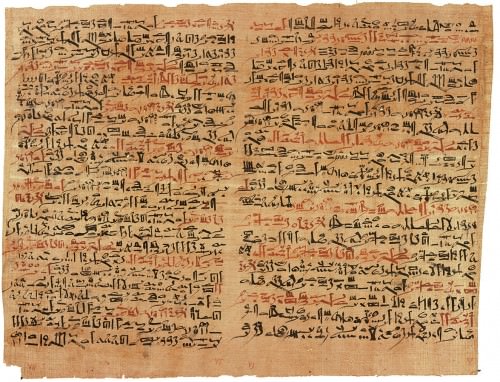
Edwin Smith Papyrus
The Edwin Smith Papyrus is the best known for practical procedures addressing injuries, but there are others which offer the same kind of advice for disease or skin conditions. Some of these were obviously ineffective - such as treating eye ailments with bat's blood - but others seem to have worked. Invasive surgery was never widely practiced simply because the Egyptian surgeons would not have considered this effective. Egyptologist Helen Strudwick explains:
Because of the limited knowledge of anatomy, surgery did not go beyond an elementary level and no internal surgery was undertaken. Most of the medical instruments found in tombs or depicted on temple reliefs were used to treat injuries or fractures which were possibly the result of accidents incurred by workers on the pharaohs' monumental building sites. Other implements were used for gynaecological problems and in childbirth, both of which were treated extensively in the medical papyri. (454)
The Kahun Gynaecological Papyrus (c. 1800 BCE) is the oldest document of its kind dealing with women's health. Although spells are mentioned, many prescriptions have to do with administering drugs or mixtures without supernatural assistance, as in the following:
Examination of a woman bed-bound, not stretching when she shakes it,
You should say of it 'it is clenches of the womb'.
You should treat it by having her drink 2 hin of beverage and have her spew it up at once. ( Column II, 5-7)
This particular passage illustrates the problem in translating ancient Egyptian medical texts since it is unclear what "not stretching when she shakes it" or "clenches of the womb" mean precisely, nor is it known what the beverage was. This is often the case with prescriptions where a certain herb or natural element or mixture is written as though it is common knowledge needing no further explanation. Beer and honey (sometimes wine) were the most common drinks prescribed to be taken with medicine. Sometimes the mix is carefully described down to the dose, but other times, it seems it was assumed the doctor would know what to do without being told.
CONCLUSION
As noted, the physicians of ancient Egypt were considered the best of their time and frequently consulted and cited by doctors of other nations. The medical school at Alexandria was legendary, and the great doctors of later generations owed their success to what they learned there. In the present day, it may seem quaint or even silly for people to believe that a magical incantation recited over a cup of beer could cure anything at all, but this practice seems to have worked well for the Egyptians.
It is entirely possible, as a number of scholars have suggested, that the success of the Egyptian doctor epitomizes the placebo effect: people believed their prescriptions would work, and so they did. Since the gods were so prevalent an aspect of Egyptian life, their presence in curing or preventing disease was no great leap of faith. The gods of the Egyptians did not live in the far-off heavens - although they certainly occupied that space as well - but on the earth, in the river, in the trees, down the road, in the temple in the city 's center, at the horizon, noon, sunset, through life and on into death. When one considers the close relationship the ancient Egyptians had with their gods it is hardly surprising to find supernatural elements in their most common medical practices.
LICENSE
Article based on information obtained from these sources:with permission from the Website Ancient History Encyclopedia
Content is available under License Creative Commons: Attribution-NonCommercial-ShareAlike 3.0 Unported. CC-BY-NC-SA License